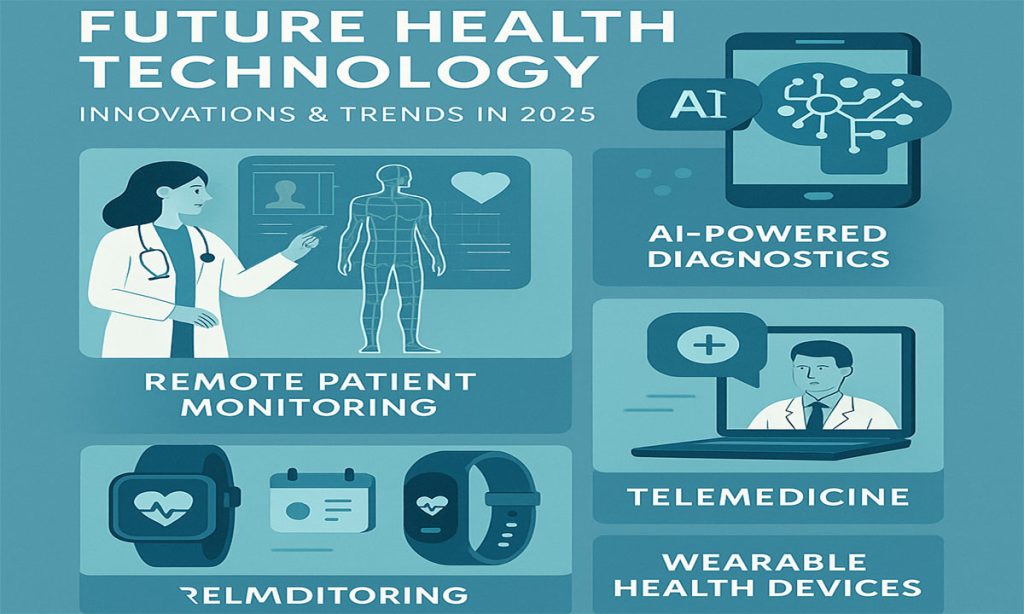Future health technology is more than a buzzword; it represents a real shift in how we approach wellness and care. By 2025, breakthroughs like AI-driven diagnostics, advanced telemedicine, and wearable devices will become mainstream. The future of digital health is evolving rapidly – from virtual care trends to predictive health monitoring, these innovations are creating new opportunities for patients and practitioners. This wave of technology also spawns exciting future health jobs and supports innovative future health startups. In this article, we explore key health tech trends and predictions shaping the next era of medicine.
For a quick overview, we will cover trends such as:
- AI and Machine Learning: Smarter diagnosis and personalized treatment using data-driven algorithms.
- Wearable Devices & Monitoring: Smartwatches, biosensors, and future health devices that track vital signs in real time.
- Telemedicine & Virtual Care: Video consultations, remote patient monitoring, and other virtual care trends enabling digital-first healthcare.
- Personalized Medicine: Genomic testing and tailored therapies driving the future of digital health.
- Health Tech Startups: Innovative companies pushing the boundaries of medical technology.
- Future Health Jobs: New career paths in healthcare technology, from health data scientists to telemedicine specialists.
Table of Contents
The Rise of Future Health Technologies
Healthcare is being transformed by a wide range of emerging innovations. Leading categories include digital health platforms, AI-driven tools, wearable sensors, and biotech breakthroughs. These future health technologies promise to make care more proactive, personalized, and accessible. For example, data analytics can sift through patient records to identify risk factors, while smart devices can alert doctors in real time if a patient’s vital signs indicate a problem Future health technology
For patients, this means having medical tools at their fingertips. Anyone with a smartphone and connected devices can monitor their own health and share results instantly with their doctor. Wearable patches or home lab kits might collect data that once required a hospital visit. In practice, integrating these future health technologies will blur the lines between hospitals and homes. Healthcare providers will leverage this constant stream of data to intervene earlier – for instance, a remote monitor might detect an irregular heartbeat and trigger an urgent care notification. Overall, the rise of these future health technologies will reshape how and where we receive care Future health technology
- Artificial Intelligence & Machine Learning: AI tools analyze medical images for disease detection, recommend personalized treatment plans, and predict patient risks from data.
- Telemedicine Platforms: Online systems and apps that connect patients to healthcare providers remotely for virtual consultations.
- Wearable Health Monitors: Devices like smartwatches and biosensors continuously track health data (heart rate, sleep, activity) and even diagnose issues early.
- Personalized Medicine: Genetic testing and precision therapies that tailor treatment to each individual patient’s biology.
- Health Data Analytics: Big data platforms that turn health records into actionable insights for disease prevention and treatment optimization.
- Robotics & Automation: Surgical robots and automated tools that improve precision and efficiency in hospitals and labs.
AI in Healthcare Future: Transforming Patient Care
A key pillar of future health technology is artificial intelligence (AI). AI systems are already assisting doctors by analyzing scans and lab results to detect diseases earlier. Machine learning algorithms can predict which patients are at risk for conditions like diabetes or heart disease based on patterns in their health data. By 2025, we expect AI tools to be even more integrated into care. For example, an AI assistant could review a patient’s medical history and suggest potential diagnoses, or personalize treatment options based on individual patient profiles. These AI tools will make healthcare faster and more accurate future health technology.
Generative AI and natural language processing (NLP) are also emerging in healthcare. Chatbots and virtual assistants powered by large language models can help patients navigate the healthcare system, remind them to take medication, or answer common questions. On the provider side, AI can draft clinical summaries and highlight unusual trends in patient records. These AI in healthcare future applications show that nearly every aspect of health tech will become more intelligent. Of course, implementing AI requires careful validation and unbiased data to ensure predictions are safe and reliable future health technology.
- Diagnostics: AI algorithms analyze medical images (X-rays, CT scans, MRIs) and test results to identify diseases earlier and more accurately than traditional methods.
- Predictive Analytics: AI forecasts patient risks (like sepsis or readmission) based on trends in their health data, enabling preventive action.
- Virtual Assistants & Chatbots: These provide 24/7 support by answering patient queries, scheduling appointments, and even performing initial triage.
- Drug Discovery: AI accelerates the identification of new drug compounds by simulating how molecules interact, reducing the time for research.
- Robotic Surgery: Intelligent robots assist surgeons with precision tasks, leading to minimally invasive procedures and faster recovery times.
Analysts predict the AI health market will grow from around $22 billion in 2023 to over $200 billion by 2030, reflecting its enormous impact. For example, some estimates suggest AI could help reduce healthcare costs by over $10 billion by 2025 through efficiency gains. The takeaway is clear: AI is not a distant science fiction – it is becoming an integral part of future health technology.
Telemedicine and Virtual Care Trends: The Future of Digital Health
Telemedicine is a cornerstone of modern healthcare, and its evolution is a major part of future health technology. Remote and virtual care have surged thanks to better internet connectivity and shifting patient expectations. Patients can now consult with doctors via video calls from their homes, making healthcare more convenient than ever. Virtual clinics and telehealth apps allow for routine checkups, chronic disease management, and even specialist consultations online. This shift is one of the most important virtual care trends in healthcare. For example, in rural areas, future health technology like satellite-enabled clinics is connecting patients to specialists far away.
Patient using future health technology via a telehealth video consultation device. Telemedicine allows patients to consult doctors via video, reaching even rural communities. For clinicians, virtual care means adjusting workflows: hospitals now implement digital check-ins, e-prescriptions, and remote monitoring programs. Insurers are increasingly covering telehealth services. These changes show how any future health technology must fit into a larger healthcare ecosystem. For instance, a patient’s wearable devices can feed data into telehealth platforms, allowing a doctor to adjust treatment plans immediately based on live metrics future health technology.
In the coming years, we expect even more innovation: AI-powered symptom checkers, 5G-enabled remote surgery, and expansive remote patient monitoring programs. Combined with connected health devices, the entire care model will become more decentralized. By leveraging these trends, health systems aim to reduce costs and improve access. Virtual reality (VR) and augmented reality (AR) are also entering healthcare: VR programs are emerging for rehabilitation and mental health therapy, while AR can assist surgeons by overlaying imaging data during operations. All of these virtual care trends help create a more patient-centered experience.
For example, telehealth usage skyrocketed during the COVID-19 pandemic: some studies reported over a 700% increase in virtual visits at the height of the crisis. Even now, surveys suggest that more than half of patients have tried telemedicine, and roughly two-thirds find virtual visits as good as or better than in-person care. This momentum indicates that video consultations will remain an integral part of future health technology.
Wearable Future Health Devices and Monitoring
Wearables are among the most visible aspects of future health technology for consumers. Smartwatches and fitness bands have already popularized heart rate and sleep tracking. In the future, we will see even more advanced devices. For instance, continuous glucose monitors (CGMs) are now standard for many diabetics, and smart contact lenses are being developed to monitor blood sugar in tears. The wearable future health market is booming: by 2025, revenue from smart health wearables is projected to exceed $50 billion globally. Market analysts forecast the global wearable health market could reach around $60 billion by 2025, fueled by consumer demand for connected fitness and medical devices. With battery life improving and AI becoming embedded in gadgets, future health monitoring will become even more proactive – for example, devices might automatically alert clinicians to irregular health patterns before patients even notice symptoms of future health technology.
- Smartwatches & Fitness Trackers: These measure heart rate, activity, sleep, and more. Some models can even perform medical-grade ECGs and detect falls.
- Continuous Glucose Monitors (CGMs): Wearable sensors that provide real-time blood sugar readings, greatly aiding diabetes management.
- Smart Clothing & Patches: Garments or skin patches embedded with sensors to track respiration rate, blood pressure, hydration levels, and other vitals.
- Implantable Monitors: Tiny devices inserted into the body, such as advanced pacemakers or other biosensors, which continuously transmit data to doctors.
- Portable Diagnostic Tools: Handheld devices that connect to smartphones to measure blood pressure, oxygen levels, or perform simple lab tests in minutes.
- Home Monitoring Kits: Complete kits with scales, blood pressure cuffs, and pulse oximeters that sync with online health platforms for clinician review future health technology.
These wearable and home health monitors encourage healthy habits and alert providers to problems early. For example, a smartwatch might detect an irregular heartbeat and send an alert to the patient’s cardiologist. Researchers are even developing printable electronics that could turn everyday clothing into health monitors. Together, these devices make future health monitoring continuous and seamless, collecting data that once required a clinic visit.
Future Health Startups: Driving Innovation
The surge in health technology innovation is being led largely by startups. Future health startups range from small biohacking teams to digital medicine companies backed by major investors. These companies tackle ambitious goals: curing diseases with gene editing, creating on-demand doctor apps, and building AI tools for diagnosis. For example, digital therapeutics startups create evidence-based apps to treat conditions like insomnia or chronic pain. Other startups focus on wellness, offering apps for guided meditation or personalized nutrition plans future health technology.
Many startups also focus on personalized medicine. Biotech companies are developing home genetic testing kits so individuals can tailor their diets or medications to their DNA. Another area is aging tech: startups are designing sensors and AI algorithms to help seniors live independently, with systems that detect falls or health declines. Entrepreneurs and investors alike are focusing on future health technology because of the high demand for medical innovation future health technology.
- Digital Therapeutics: Software programs prescribed to treat specific conditions (e.g., apps for diabetes management or stress reduction).
- Genomics & Biotech: Companies providing genetic tests and personalized drug designs, enabling treatments that match an individual’s biology.
- Telehealth Platforms: Virtual care networks and apps connecting patients with physicians anywhere, including specialized telemedicine services.
- AI-Powered Healthcare: Startups offering AI for medical imaging, genomics analysis, and healthcare data analytics.
- Robotics & Devices: Startups creating surgical robots, automated lab machines, or advanced prosthetics.
- Wellness & Preventive Tech: Apps and wearables aimed at fitness tracking, nutrition coaching, or cognitive training.
Investment in health tech startups remains strong. In recent years, venture funding for digital health has hit record highs. In fact, there are already hundreds of “healthtech unicorns” (startups valued over $1 billion), highlighting investor confidence. Industry databases list thousands of health technology startups worldwide, many focused on digital therapeutics, biotech, and remote monitoring. This robust startup ecosystem means patients are likely to see new solutions reaching the market faster than ever before. Partnerships between startups and hospitals help ensure these innovations truly address clinical needs.
Future Health Jobs and Careers
As technology reshapes healthcare, the workforce will evolve. Future health jobs will blend clinical knowledge with tech expertise. Healthcare organizations will hire more data analysts, software developers, and tech-savvy specialists. For example, a hospital might employ a health data scientist to analyze patient outcomes, or an AI engineer to develop diagnostic tools. Roles like “Digital Health Officer” or “Telehealth Coordinator” are already appearing in many health systems. Medical and nursing schools are updating their curricula to include data science, informatics, and telemedicine training. Even employers now seek candidates with digital health experience.
- Clinical Informaticist: A clinician who bridges IT and care, optimizing electronic health record systems and workflows.
- Digital Health Coach: Educates patients on using medical apps and devices to manage their health.
- Genomic Counselor: Interprets genetic test results and guides patients through personalized treatment plans.
- Remote Monitoring Nurse/Physician: Delivers care through telemedicine and monitors data from patients’ home devices.
- Healthcare Cybersecurity Analyst: Secures patient data and hospital networks against cyber threats.
- Healthcare UX/UI Designer: Creates user-friendly interfaces for doctors and patients interacting with health apps.
Job postings for health data and technology roles have surged. Some job platforms report double-digit year-over-year increases in listings for “health data analyst” or “AI healthcare engineer”. Professionals with combined expertise in medicine and data science are highly sought after, making informatics and analytics valuable career paths. The key point is that careers in healthcare will increasingly be multidisciplinary: a nurse might spend part of her week analyzing a patient’s wearable-device data, while an engineer might spend time in a clinic understanding medical workflows.
Biotechnology and Gene Editing
Biotechnology and gene editing represent a frontier in healthcare innovation. Techniques like CRISPR allow scientists to modify DNA, potentially curing genetic diseases that were once untreatable. For example, clinical trials are underway to use gene therapy for conditions like sickle cell anemia and inherited blindness. In the future, doctors might use future health technology to 3D-print tissues and organs on demand. Researchers are developing ways to grow a patient’s own cells into custom implants, potentially ending organ transplant shortages. Nanotechnology is another emerging area: scientists are designing nanoparticles that can deliver drugs directly to tumors or other disease sites, minimizing side effects. These tiny carriers might one day swim through the bloodstream to find and treat problems at the cellular level.
While these technologies are still in early stages, they are part of the future of medicine. Together, biotechnology, gene editing, and nanomedicine have the potential to redefine how we treat chronic diseases and injuries. Keeping an eye on these trends is important, as they could bring about life-changing treatments by the mid-2020s.
- Gene Therapy: Correcting faulty genes with new DNA to treat hereditary diseases. Future health tech startups are already using these methods in trials.
- 3D Bioprinting: Printing tissues and organs on demand using a patient’s own cells. This could eventually eliminate organ transplant shortages.
- Nanomedicine: Using nanoparticles and molecular machines to diagnose and treat disease at the cellular level. For example, tiny bots could deliver chemotherapy directly to tumor cells, reducing side effects on healthy tissue.
- Regenerative Medicine: Encouraging the body to heal itself by growing new tissue or organs from stem cells, aided by advanced biotech tools.
Challenges and Considerations
While future health technology promises many benefits, challenges must be addressed. Privacy and security is a top concern: with more health data online, protecting patient information is critical. Robust encryption and strict compliance with regulations (like HIPAA in the U.S. or GDPR in Europe) are required. Regulation and reimbursement also lag behind innovation; new devices and software often need official approval, and insurance policies must adapt to cover digital services and remote monitoring.
Equity is another issue. Not all patients have equal access to technology. To prevent a digital divide, innovations must be affordable and available to rural or low-income communities. Investments in broadband internet and telehealth access are essential. Interoperability is a challenge as well; many new apps and devices must communicate with existing health systems. Industry standards (like HL7 and FHIR) are emerging to solve this, but progress takes time.
- Ethical Use: Algorithms can be biased if trained on unrepresentative data. Developers must ensure AI and other tools are fair and transparent. Patients should have control over who accesses their data.
- Training & Adoption: Clinicians and patients need education to use new tools effectively. If a medical app or device is hard to use, even the best technology will fail to help.
- Cost & Infrastructure: Upgrading hospitals and clinics to handle new tech can be expensive. Many legacy systems are decades old, and lack of standardization can slow integration. Overcoming these technical hurdles is key to making future health technology work seamlessly.
Addressing these issues requires collaboration among governments, health systems, and tech companies. For example, the WHO has released digital health strategy guidelines to encourage countries to adopt electronic systems and telemedicine. Pilot programs and real-world studies can prove value and safety. By prioritizing privacy, equity, and usability, stakeholders can help ensure that innovations in future health technology truly benefit everyone.
Future Health Predictions and Outlook
Looking to 2025 and beyond, here are some key predictions:
- Widespread Virtual Care: Routine follow-ups and checkups will often be conducted online, saving travel time and reducing overcrowding in clinics.
- AI-Powered Decisions: Doctors will routinely use AI-driven decision-support tools to reduce errors and personalize treatments.
- Home-Based Treatment: Many therapies (like IV infusions, physical therapy, or remote monitoring) will happen at home, supported by nurses or mobile clinics. The “hospital-at-home” model will expand.
- Precision Medicine: Genetic testing and biomarker analysis will guide tailored treatments, so that medications and doses are chosen based on a patient’s unique biology.
- Advanced Robotics: Robots will perform more tasks in hospitals, from assisting in surgeries to automating logistics. Even friendly robotic helpers might assist patients in their rooms or at home.
- Secure Data Sharing: Technologies like blockchain could enable patients to control and share their medical records securely across providers.
- Mental Health Goes Digital: VR therapy and mental health apps will become mainstream options for psychological care.
- Early Disease Detection: Continuous monitoring and big data analytics may allow health systems to catch diseases months earlier than current methods.
These future health predictions reflect a broader trend toward a more connected, preventive, and personalized healthcare system. If innovators, providers, and regulators work together wisely, by 2025 the healthcare system could be much more data-driven and patient-centered than ever before.
Conclusion
In summary, future health technology is set to revolutionize healthcare by 2025. Innovations in AI, digital platforms, wearables, and telemedicine will make care more predictive and patient-centric. Patients will use smart devices to manage their health, while clinicians leverage data to make better decisions. At the same time, new health jobs – like data analysts and telehealth coordinators – will emerge. Embracing future health technology together – patients, providers, and innovators – can build a more efficient and accessible healthcare system.
If you found these insights valuable, share this article on social media and leave a comment below. We’d love to hear your thoughts on the future of health technology and innovations. Together, we can help shape a healthier tomorrow!
Frequently Asked Questions
What is future health technology?
Future health technology refers to the cutting-edge tools and innovations that will shape healthcare’s future. This includes AI-driven diagnostic systems, wearable health monitors, telemedicine platforms, and personalized medicine solutions. These technologies aim to improve disease prevention, diagnosis, and treatment, making care more efficient and patient-centered. Together, these advancements are often referred to as “future health technology,” reflecting the new direction of healthcare.
How will AI impact the future of healthcare?
AI will play a major role in diagnosing diseases, personalizing treatments, and automating routine tasks. For example, machine learning algorithms can analyze medical images to detect issues earlier than a human might, and AI-powered chatbots can handle patient inquiries 24/7. By 2025, AI tools are expected to help doctors identify conditions sooner and recommend customized therapies, improving outcomes and reducing costs. Integrating AI is a key part of future health technology’s impact on medicine.
What are some examples of wearable future health devices and monitors?
Wearable future health devices include smartwatches that track heart rate, sleep, and activity; continuous glucose monitors for diabetics; and advanced wearable ECG or blood pressure monitors. Other examples are smart clothing with embedded sensors and implantable devices like miniaturized cardiac monitors. These gadgets collect real-time health data and enable continuous health monitoring, alerting users and doctors to issues before symptoms appear.
What are virtual care trends shaping healthcare?
Virtual care trends involve the expansion of telehealth and online health services. This includes video doctor appointments, remote patient monitoring through connected devices, and mobile health apps. Emerging trends also include VR/AR therapy for rehabilitation and AI-driven virtual assistants. These trends allow patients to receive care from home, making healthcare more convenient and accessible – a key aspect of the future of digital health.
What new jobs will emerge in healthcare by 2025?
New roles will blend healthcare and technology. Examples include health data scientists analyzing medical data, AI engineers developing intelligent diagnostic tools, and telehealth coordinators managing virtual care programs. Other roles will be clinical informaticists, genomic counselors, and digital health coaches. In short, the growing field of future health technology will demand professionals who understand both medicine and tech.
What challenges will future health technology face?
Key challenges include ensuring patient privacy and data security, and complying with regulations for new devices and apps. There are also concerns about equitable access: innovations must be affordable and usable by underserved communities. Technical issues like data interoperability and ethical issues like bias in AI must be managed. Addressing these challenges is crucial to ensure that innovations in future health technology are safe, effective, and benefit all patients.
How will biotechnology shape the future of healthcare?
Biotechnology will enable more personalized and curative treatments. Gene editing tools like CRISPR may cure genetic disorders by correcting DNA mutations. 3D bioprinters might create custom tissues or organs for transplant, reducing waiting lists. Nanotechnology could allow targeted drug delivery to kill cancer cells without harming healthy tissues. These advances in biotechnology are part of the future health technology revolution, moving us toward treatments that heal the body at the molecular and cellular level. This could solve previously incurable conditions.
What is the future of digital health?
The future of digital health refers to the evolving role of technology in healthcare, including telemedicine, mobile health apps, wearable devices, and data analytics. It overlaps with ‘future health technology’ and covers all innovations that improve healthcare delivery through digital means. By 2025, digital health is expected to be commonplace in clinics and homes, with patients using devices and apps to stay healthy and informed.
How can I prepare for a career in future health technology?
Preparing for a career in future health technology involves building skills in both healthcare and technology. Pursue education in fields like health informatics, biomedical engineering, data science, or a related area. Hands-on experience is valuable: internships at hospitals, participating in health tech projects, or obtaining certifications can provide practical insight. Stay updated on industry trends by following digital health news and attending relevant workshops. By combining clinical knowledge with tech expertise, you’ll be well-equipped for the healthcare jobs of tomorrow.





